Cross functional teams are complete in expertise but not necessarily collaborative. Sometimes team members hold on to their expertise too much and the team does not perform to its potential. This Lego game illuminates the difference when members allow themselves to take on tasks outside their expertise, being so called T-shaped. Play the game to kick-start your change and create collaboration.
Background
Sometimes you hear during stand up phrases like “there’s nothing on the board for me” or “the story is blocked until she comes back”. Those are signs of silos and a team not working at full potential.
Cross-functional teams are teams with different areas of expertise that covers enough to create a product and put it into production. However, it is not enough to put together a group of differently skilled persons, usually experts on their area, and expect them to deliver as a team. This game tries to convey the consequences of holding on to your primary expertise and role only.
Preparations
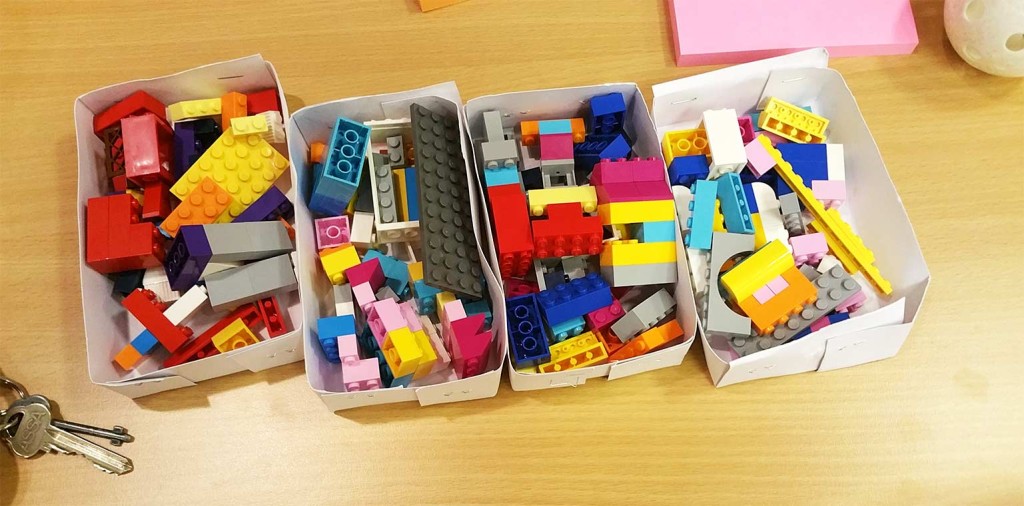 Lego in boxes prepared for 4 teams.
Lego in boxes prepared for 4 teams.
- Divide the Lego bricks in 4 stacks, based on colour. Each colour represents a skill.
- Each player gets a stack of at least 12 bricks. If fewer than 4 players, a player can handle more than one stack.
- Place the game poster on the table, one for each team.
How to play
On the board there are three user stories in priority order. To complete a story, bricks are to be placed in the order as shown in the story. A game consists of 5 rounds (an iteration). Begin the round by marking it on the poster. Each round, every player, in turn, takes a brick and places it as shown in any of the stories. Order of players are: yellow, white, red, blue.
If a player can’t place a brick, that is noted as a missed turn on the board.
When a story is completed, the round which it was completed on is noted on the board.
After 5 rounds, the game ends. Note how many stories were done, how many turns were missed and how much work had been put in unfinished stories. Then wait for instructions for the next phase.
Facilitator instructions
Download the poster and print it on A3 paper, 2 for each team.
Free download of the X team silos game poster in PDF here >
The game takes about 20 – 30 minutes to play.
Place groups by 4 with the game poster on the table along with the exact number of pieces of Lego in each colour. If there are 5 people in the group, you ask one of the players to be the “scrum master” or facilitator of the team, and ask that person to take notes and handle the process of the game. If there are only 4 players, you ask who in the team will be the facilitator, that person will then be a player as well. With less than 4 players, a person may handle more than one colour.
The colours must also be in the right order, as shown on the poster, to make the game work well.
It is important that you tell the players that the different colours represent different expert roles, pick roles that they have in their organisation to connect to their reality. Red could be the tester, white the back end developer, yellow the UX and blue the front end developer.
The game runs in 2 iterations, after the first iteration you make a big metric board (see image) and ask each team to report their metrics.
- On what round did they finish each story?
- How many missed turns?
- How many unfinished stories?
It can also be very interesting to see how different results each team get.
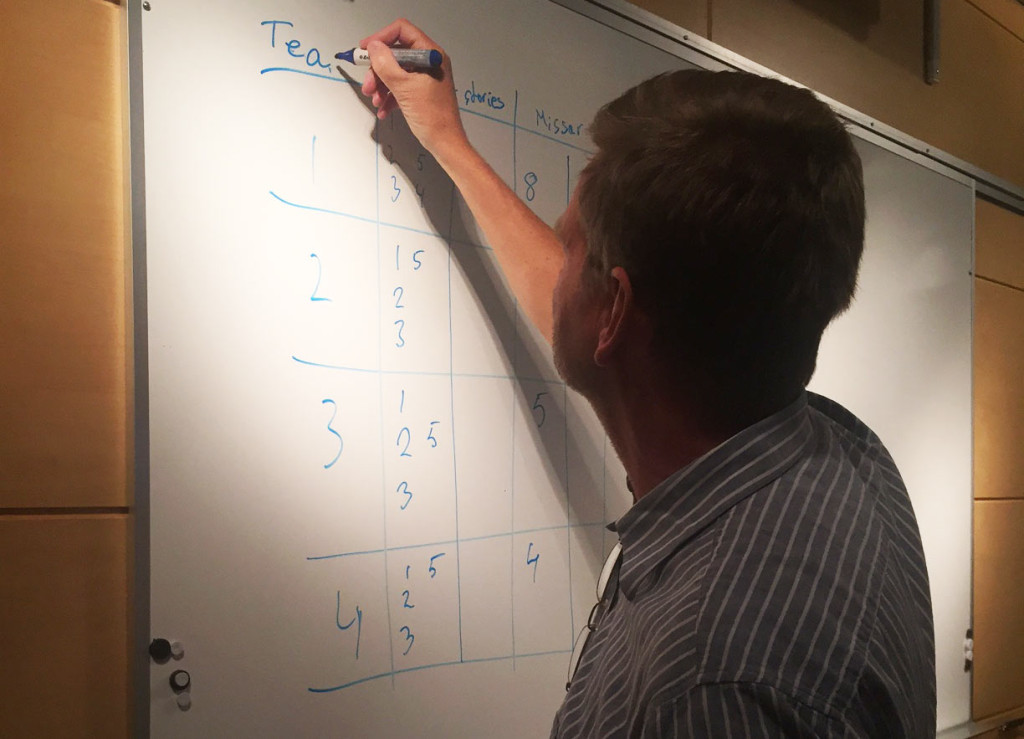 Per is facilitating the game and asks the teams for their metrics after each iteration.
Per is facilitating the game and asks the teams for their metrics after each iteration.
Second Iteration
Start the second iteration by giving all teams new copies of the poster and ask them to break up the Lego pieces again, bring it back in 4 colour stacks. But now they should all give away 2 pieces of their colour to each player. All players should now have 6 of “their” colour and 2 pieces of the other colours. Now they are more likely to be able to help each other and work as a team since all team members are allowed use more competences than one. This is something we call T-shaped team members, you have a main area of expertise but can do some work outside of it.
After the second iteration you take all metrics again from each team. Compare with the first iteration. Now you can have discussions around team work where all team members can help out and how that affects their deliveries. Ask the group for their reflections after the game has ended, there is usually a lot if these type of problems exists.
Example of questions to discuss after last iteration:
- What would happen if I only do one type of work and I go for a leave?
- What happens if one team member’s expertise is not included in the most prioritized story?
- What would happen if we would let some other team “borrow” the yellow player in the first round?
- What happens when we don’t deliver the most prioritized story, but all the rest?
- What happens if all stories are unfinished in the end of a sprint because of how we work?
- What happens when some team members only can do their work in the end of the sprint, and all others are done?
- What happens when we split our stories so that every one can help out?
- What happens if we let not only experts do all type of work. How can we make that possible in reality?
- What would happen if we stopped having roles as titles, and “just” team-members instead?
This game was created by Per Lundholm and Mia Kolmodin, tailored to be a part of our course “Lean Team” to make the course participants experience the problems with Agile teams working in silos and how that easily can be improved – and then we teach them the tools, methods and process to do so during the course 🙂 Let us know if you are interested in taking the course internally for all your teams, then we can come and visit you, or if you want to participate in our open course at Crisp.
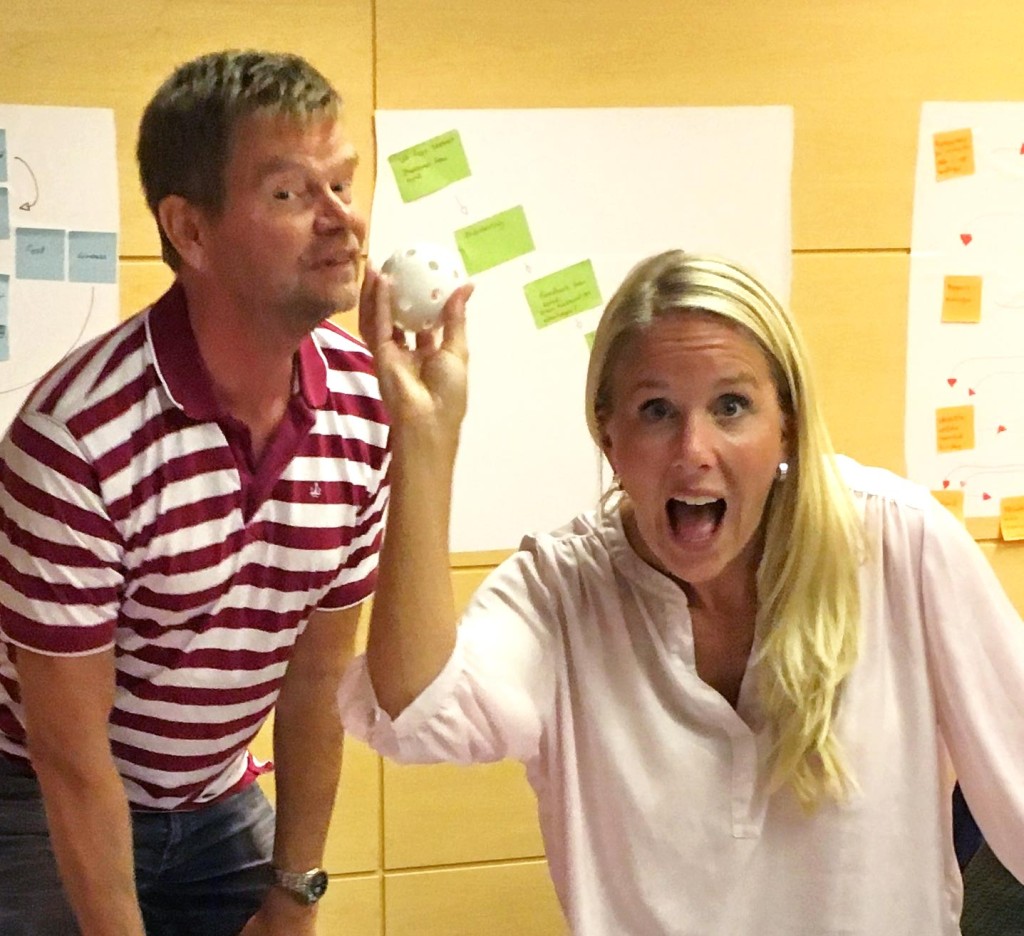 Let us know what you think 🙂 The ball is in your court now!
Let us know what you think 🙂 The ball is in your court now!
Hope you will enjoy the game and that it works for you to improve collaborative work in teams.
We would love if you would let us know what you think!
Translations
x teams silos game Russian
EDIT: We just received greetings from Agile friends in Russia, with a translated game! This made us so happy 🙂 Feel free to use it you too if you speak Russian.
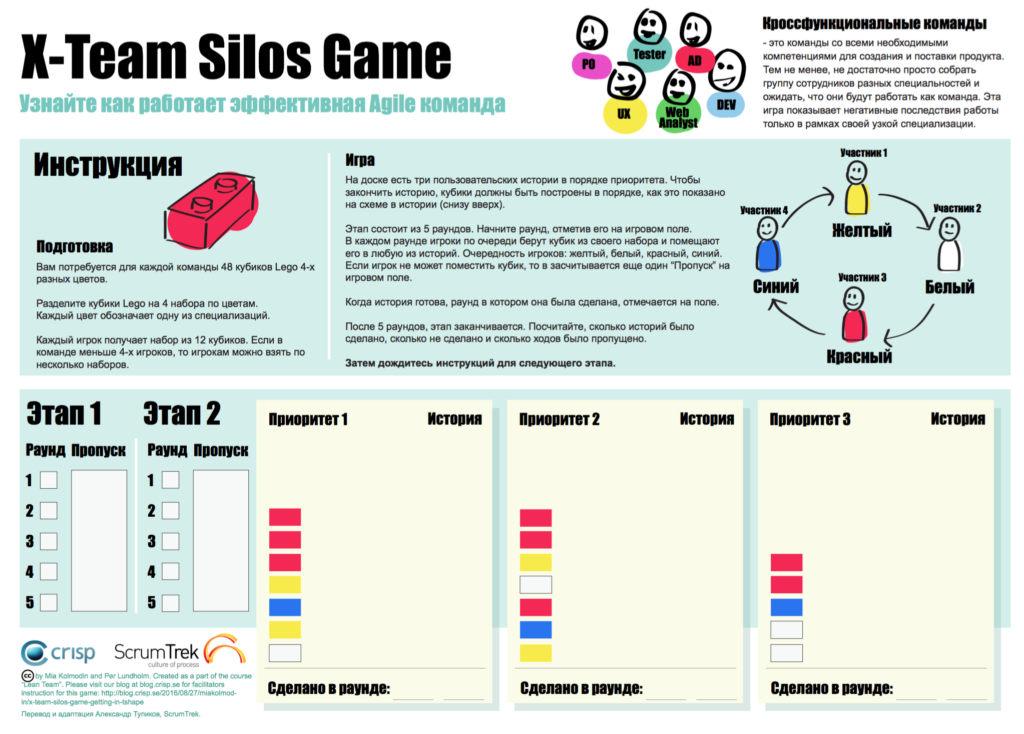





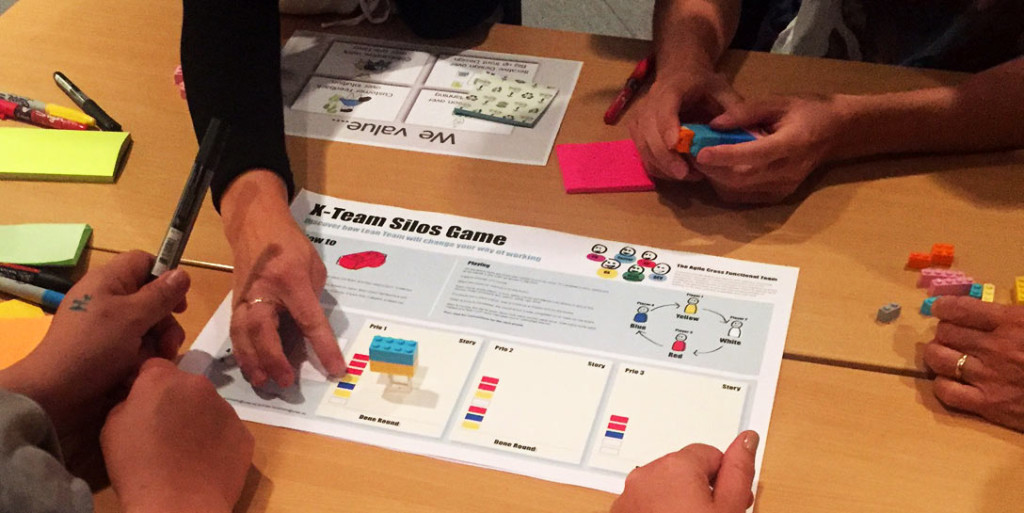
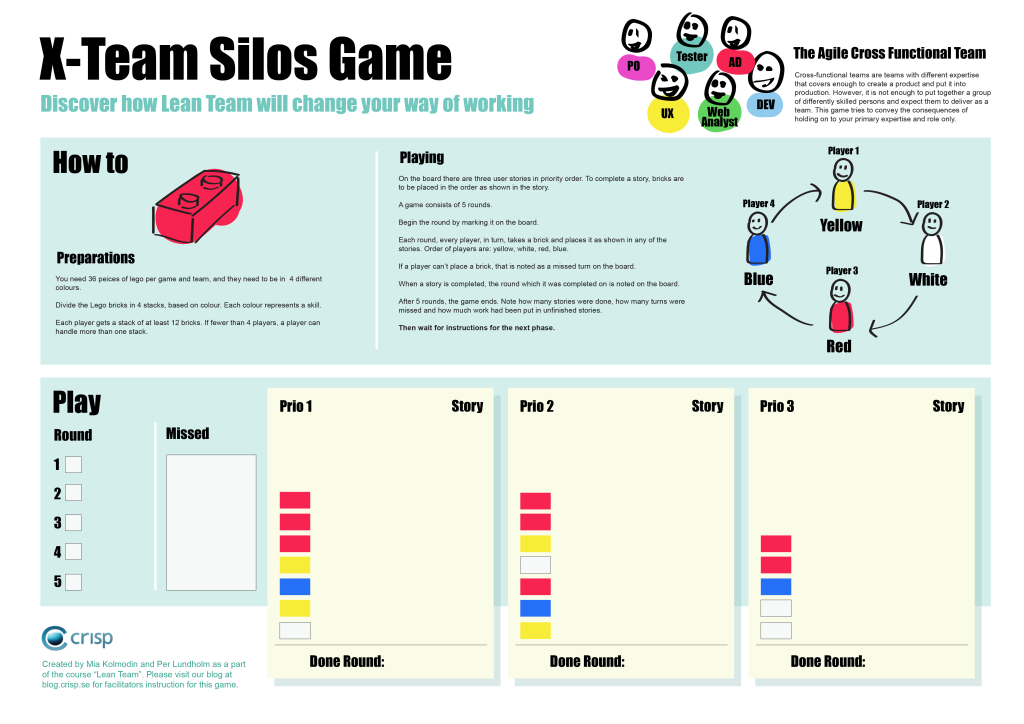

AIGLU launches its first Playground where we will discover serious games or fun workshops in a welcoming environment around Agile Values, October 3 @ 17 h 45 – 20 h 00 at the BGL BNP Paribas Business Center venue.
We are looking forward to playing the X-team Silos Game!
https://sublimedelivery.wordpress.com/2016/09/23/the-x-team-spirit/
Hi Bart! We are happy to hear that you tried the game. How did it go, did you get great discussions?
It was striking to see how the game relate directly to the benefits of collaboration. Values like diversity, egalitarian, partnership, interaction, synergy and trust popped up and enabled the teams to accelerate their delivery process. Wow. A great game!
Unfortunately, I have though to admit that I failed somehow to enable a thought-full discussion regarding “Ops-expertise” when an Ops expert argued that in reality, people like him find it extremely hard, almost impossible, to take T-shaped roles. But, impossible is not agile. So how can we make it possible then? All Ideas are welcome.
It happens that individuals argue that in their case, things are special and they can do no work but what goes with their expertise. But I believe it being a matter of personality rather than their role. If it has to do with them being overloaded with work, I ask what would happen if you got sick and stayed home for a long time. If they cling to their job for reasons of security, I ask what would happen if your job was outsourced. It might be a bit tough so instead one can ask what they would do at their job if they were not doing what they do now.
Hej,
In addition check also Mike Cohn’s point of view in his article “Cross Functional Doesn’t Mean Everyone Can Do Everything”.
Follow https://www.mountaingoatsoftware.com/blog/cross-functional-doesnt-mean-everyone-can-do-everything.
Simple and cool!
Bart
Encouraging collaboration and removing silos between development (Dev) and operations (Ops) is key in order to ensure faster flow of value to business (Buz).
My suggestion is to organize the game by setting up :
– teams with exclusively Buz and Dev expertise and,
– teams with combined Buz, Dev and Ops expertise.
At the end of the game, include a discussion around the benefits of increased DevOps collaboration and how it contributes to reduce the distance with Business if you have the right culture!
Really great game for visualizing to benefit of being more T-shaped. We have had that discussion for some times within my teams so I used this exercise/game at a “Friday fun day” that I have introduced were we do Agile games or only fun games. This game really showed them the benefits of being T-shaped and we had great discussions afterwards within the teams(4 of them) and they all created a list of actions that they will do to be more T-shaped.
A small typo in the preparations instructions, you need 48 pieces of lego.
Thank you for sharing this game!
Christer
Thank you so much, Christer!
Really happy to hear that the game had the intended effect.
Is there anything you can share from the list of actions to get into being more T-shaped?
Thanks for this article. In our way to getting two new teams up and running in 2018, with different roles, we want our teams to be working on getting T-Shaped.
Just wondering: What is your definition of T-Shaped? What is your definition of Crossfunctional? And how do these concepts relate to eachother?
thanks in advance,
Joost van Poppel
Thanks for your comment Joost!
To me, the team is cross-functional when it, as a team, has the competences and privileges to deliver without support from some other teams. This avoids hand-overs and queues. Also, the team has solid understanding of the consequences of their work when they have the whole picture.
Somebody who is T-shaped recognise that while they have a competence area where they excel, they also have other areas where they can chime in. By team members not being locked in your primary competence area, the team delivers much better which is demonstrated by this “X-team silos” game.
The concepts are related in that to be cross-functional, team members has to work in more than one area or the team probably would become very large to cover all areas needed.
Hi!
Thank Mia Kolmodin and Per Lundholm for such fun solution for increasing communication and collaboration level of cross functional teams. I’m not working in team that develop digital products, but still in very close industry – digital marketing. We have been playing it for four weeks now and the result are great!
That is really great to here! Thanks for sharing.
Hi,
Thanks for sharing such a wonderful game.I did it with my team..it was quite impactful and thought provoking.
Also bit of tweaking/outliners to bring it more into our context.
– Each Round is called as “each Day” work
– Explicitly mentioned “In single day you can use only one lego block”
– Explicitly mentioned in Second Iteration – “If there is work on your primary skill (color), that should be done first”
Looking forward to play with other teams as well.
Thank you for your kind words! We are happy to see that you enjoyed our little game.
Using “day” for a round is an interesting idea. Perhaps we should change to it in the next version!
I am a bit hesitant to a rule pushing you to use your primary skill first. But it is a good reflection. Perhaps a question to have after the second iteration where there are many teams playing. Which ones used their primary skill first and which tried to use what was best for the team result?
so, do you have any date in mind about v2 of this game? 🙂
or can recommend any other workshop/game that addresses the same problem?
Version 2? Can’t say anyone of us is working on it 🙂
It is mostly used by my co-author, Mia Kolmodin. She has founded Dandy People so your best bet is talking to them.
thank you for great article
Hi!
Great game, is there a remote verison of this?
Not that I am aware of, perhaps I should write one…
/Per